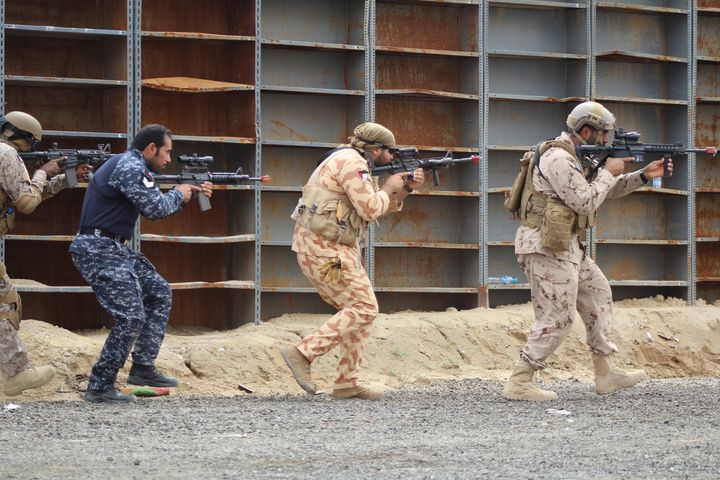
Military personnel from Kuwait, Qatar, Saudi Arabia and the U.S. conduct counter-terrorism drills as part of Eagle Resolve 2017 near Kuwait International Airport, March 28, 2017.
Internal GCC rift laid bare over renegade support for Iran, ISIS, Brotherhood
In rapid succession, a total of nine nations have announced their termination of diplomatic relations with the State of Qatar, at the behest of Saudi Arabia and buttressed most notably by the United Arab Emirates and Egypt.
As of publication, the world’s richest country by GDP per capita finds itself blockaded by air, land, and sea. Ambassadors are being sent home, embassies shuttered, planes grounded, and communications curtailed.
The timing and details of this latest spat between the dominant Gulf Cooperation Council power and the upstart city-state threaten to cement long-term divisions between Riyadh and Doha. Similar feuds have happened before, but this escalation is faster and more furious than ever before.
Historically, the international community has been ambivalent about how to deal with intra-GCC disagreements over Qatari support for a wide range of Islamist factions around the Middle East: relations with Iran and its allied militias in Yemen, Lebanon, and Bahrain; backing the Muslim Brotherhood in Egypt, Libya, Tunisia, and Syria, plus Hamas in Gaza; and embracing al-Qaeda offshoots, financing ISIS fighters, and hosting a Taliban office.
While the Saudi-Emirati front also has similarly invested tremendous energy in efforts to defeat Syria’s President Bashar al-Assad, Qatar’s decent relations with Tehran and alliance with Ankara have driven a wedge through the Arabian Gulf countries. “Neutral” Kuwait, and even more so, Oman, likewise maintain ties with the Islamic Republic, but Qatar uniquely shares a massive natural gas field with Iran.
With opposing positions in conflicts from Tripoli to Cairo to Sanaa, the GCC divide has barely eased since Sheikh Tamim bin Hamad Al Thani took over from his father in 2013, and after the last tussle and subsequent reconciliation agreement in 2014. But at that time, regular Qataris were never expelled and travel routes were unaffected.
What appears brutally clear in the intense summer sun is that the anti-Qatar assault has been heating up for weeks in an orchestrated fashion. Moreover, the drive appears to have been significantly emboldened by U.S. President Donald Trump’s glowing endorsement of the Saudi monarchy in all its absolutist splendor.
One Iranian official recently tweeted, “What is happening is the preliminary result of the sword dance,” attributing the chaos to the commander-in-chief’s recent posturing.
Two different controversies also seem to have pushed the situation to a breaking point. First, the Qatari emir is alleged to have defended ties to Iran, criticized Saudi policy, and suggested that Trump may not last so long in office. Whether or not the statement was “fake news” disseminated by a hack attack, or not, these items crossed lines in the sand for Saudi King Salman bin Abdulaziz.
Then, the leaked emails between UAE ambassador to the U.S. Yousef al-Otaiba and various VIP cognoscenti in Washington D.C. exposed a growing consensus that Qatar needed to be contained. Vicious allegations flew back and forth, with Ramadan tempers perhaps fanning the flames.
At this juncture, leaders in Doha say the harsh measures aren’t “justified,” as residents of Qatar are digging in their heels for a protracted struggle. Whether the Qatari leadership will accede to a long and onerous list of regional demands is anyone’s guess. Here are three scenarios for how the crisis could unfold, in order of likelihood:
1) Qatar Surrenders to Pressure
After days, weeks, or even months of increasing sanctions that begin to make a real impact on the Qatari economy and individual pocketbooks, the elite bends to Saudi demands and realizes that wealthy citizens would rather give up national political ambitions than their financial prosperity. Turkey helps mediate, leaving the Al Thani family in control but giving up some of its chips.
Doha would be compelled to continue removing unsavory Islamists from its territory. Although it already began to expel Hamas leaders, more would follow, along with outspoken members of banned opposition groups from Egypt and other Gulf countries.
In addition, the Qataris could be asked to close or silence the following media outlets that “interfere” in domestic affairs: Al Jazeera, Al Araby Al Jadeed, and Huffington Post Arabic, among others. The 20-year-old TV channel’s Saudi office and license have already been seized.
Most importantly for the U.S., Qatar would be required to participate not just in the anti-ISIS coalition (which relies upon Al Udeid, the massive American air base, to carry out strikes) but also in the “united” Sunni front against Iranian aggression. Next, Doha would have to apply more scrutiny to charities that are used to send funds to terrorist organizations abroad.
The Trump administration would obviously prefer this outcome, with Secretaries Mattis and Tillerson sleeping better at night once key Western allies are back at the iftar table together.
2) Intra-GCC Cold War
In what would effectively mark an end to the fragile cohesion of the regional bloc, the alliance could just dissolve. Qatar would become more adamant — and honest — about its relationships with Turkey, Iran, and a wide range of Islamist militant groups. Under this scenario, Saudi attempts to force Qatar into line would completely fail to bring about rapprochement.
Doha could still host the large U.S. military presence at CENTCOM’s forward headquarters, but the regional enmity would become frustratingly awkward.
Rather than a direct military confrontation between Saudi Arabia and Qatar, the most likely expression of the feud would be in proxy wars elsewhere. One possible locale is Gaza, where the moderate Arab states have long sought to prop up a secular authoritarian leader like Mohammed Dahlan. Qatar has liberally shown its appreciation for the Palestinian Islamist leaders of the coastal territory, but heightened rivalries could result in an outbreak of war with Israel -- which has essentially become a key member of the Saudi alliance.
Renewed Qatari support for Hezbollah could also risk fresh conflict on the Lebanese border. Elsewhere, Qatar could keep punching above its weight through outsized influence with militant groups in Yemen and Libya. The internal GCC tensions would be perpetuated, yet other countries and their people would pay the price.
3) Coup Imposes New Leadership
Either through softer “guardianship” or a full-scale military intervention that installs a Saudi-friendly autocrat, this less-likely scenario would end the royal Al Thani family’s sovereignty over Qatar.
Arguably, a major part of the impetus for this approach would be the Saudi need to find a scapegoat following a sharp uptick in Western pressure to tamp down on exporting fundamentalist ideology, especially in the aftermath of the vicious Manchester and London attacks. One way to distract from the negative attention would be to shift blame to Qatar’s government for funding terrorism and promoting radical Islamists.
Qatari citizens tired of not being able to take vacations to the Maldives and Mauritius -- which have also severed ties with the thumb-shaped peninsular state -- will theoretically turn irate due to inconvenience, stigma, and growing isolation. Despite the country’s immense wealth, there will certainly be food and consumer-good shortages. Their sovereign wealth fund’s major investments abroad will become embattled. And so ultimately a large percentage of Qatari nationals -- who maintain strong tribal and cultural connections to Saudi Arabia -- could start to turn against the ruling clique.
As Riyadh and its partners in the U.S. intelligence community seek new ways to gain leverage over Iran by destabilizing ethnic minority areas, placing a puppet regime in Doha across the Gulf from the Shia arch-nemesis would further their regional aims.
Alas, while the possibility of ousting the Qatari emir doesn’t appear to be just around the corner, the war of words has dangerously morphed into something far worse. A Qatari establishment that likes to define itself in contradistinction to its Wahhabi big brother has always been critical of other capitals, unique in its foreign policy, and iconoclastic vis-a-vis conventional norms.
But perhaps Doha’s sponsorship of Islamist movements -- of all strains -- has created unprecedented and untenable friction. Oil prices, temperatures, and tensions will thus undoubtedly keep climbing sky-high.
[Full disclosure: The writer was employed by Al Jazeera from 2010 to 2016]
